(Published also today at shareable.net)
I started reading Adam Greenfield’s new book, Against the Smart City, with the expectation that it would be a critical view of the ways our urban lives have changed during the past half decade with the massive adoption of so-called “smart phones” and the rest of the ubiquitous technosphere. But it turns out he has a rather different target in mind. His polemic, delivered by EPUB and kindle only (so far), is directed at a techno-utopian fantasy promulgated by large multinational corporations and their government client-sponsors.
Specifically, he spends most of his book going point-by-point over the absurd claims of efforts to build cities in “empty” spaces; that is, brand new urban complexes built from scratch in reclaimed mudflats in the sea, or in one case in an “undeveloped” rural valley in Portugal. The three targets of Greenfield’s scathing critique are the Korean New Songdo, Masdar City in the United Arab Emirates, and a planned small city in Portugal called PlanIT Valley. “These are putatively urban-scale environments designed from the ground up with information-processing capabilities embedded in the objects, surfaces, spaces and interactions that between them comprise everyday life. They are held up before us as forerunners and exemplars of the kind of urban environment we might inhabit once the cities of Earth have been decisively colonized by networked informatics, at some point in the undefined but not-too-distant future.”
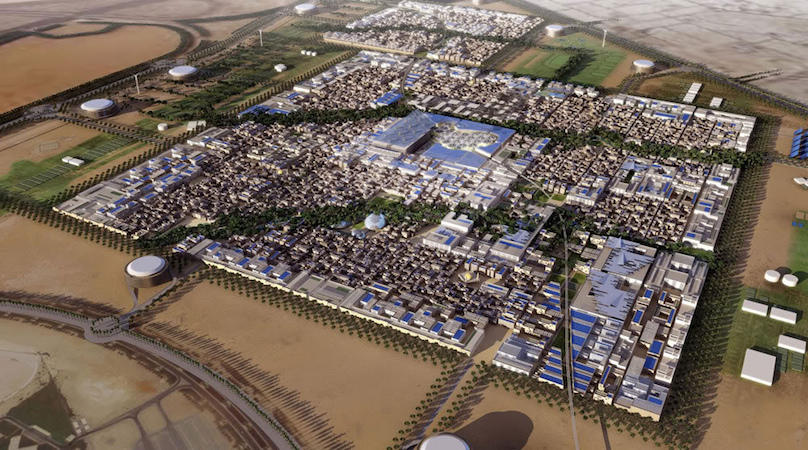
Pictured above: A rendering of Masdar City, a “smart city” in the United Arab Emirates. By Forgemind ArchiMedia under a Creative Commons license from Flickr.com.
The three big corporations at the heart of this below-the-radar industrial fantasy are IBM, Cisco Systems, and Siemens AG (of Munich, Germany). These companies are very familiar with large-scale projects and like to imagine they are capable of re-engineering life itself (IBM’s hubris-filled slogan these days is “let’s make a smarter planet”). They have all brought software- and hardware-linked systems to the market, offering urban planners a turnkey “solution” for everything that faces a generic municipal government. As Greenfield ably shows, the rhetoric, vision, and reality of these corporate schemes depends on an alarming amnesia and disregard for both history and actual knowledge about how cities really function.
While trading in the grand claims of cyberspace and seamless integration and frictionless futures, the urban life these corporations are trying to manage actually depends on real people moving through real environments, using everything from their feet to bicycles to cars and trains. Their sales pitch depends on a flattening of layered realities and omitting complex knowledge from more than a century of urban planning, history, and analysis:
Of the major technology vendors working in the field, Siemens makes the strongest and most explicit statement of the philosophical underpinnings on which their (and indeed the entire) smart-city enterprise is founded: “Several decades from now cities will have countless autonomous, intelligently functioning IT systems that will have perfect knowledge of users’ habits and energy consumption, and provide optimum service…The goal of such a city is to optimally regulate and control resources by means of autonomous IT systems.”
We act in historical space and time, as do the technological systems we devise and enlist as our surrogates and extensions. So when Siemens talks about a city’s autonomous systems acting on “perfect knowledge” of residents’ habits and behaviors, what they are suggesting in the first place is that everything those residents ever do — whether in public or in spaces and settings formerly thought of as private — can be sensed accurately, raised to the network without loss, and submitted to the consideration of some system capable of interpreting it appropriately. And furthermore, that all of these efforts can somehow, by means unspecified, avoid being skewed by the entropy, error and contingency that mark everything else that transpires inside history.
Soon after plunging into Against the Smart City I began to wonder why so much analytical effort had been spent debunking what seem to me to be patently absurd assertions by corporate PR departments. While I appreciate Greenfield’s detailed rebuttals to the Smart City propagandists, I found myself bogging down. I can’t really believe these plans are being built or will ever come anywhere near to their claims. Greenfield’s critique leaves little room for anyone to suggest that these “smart city” plans are anything but self-evidently ridiculous.
For all of the conceptual flaws we’ve identified in the Siemens proposition, though, it’s the word “goal” that just leaps off the page. In all my thinking about cities, it has frankly never occurred to me to assert that cities have goals. (What is Cleveland’s goal? Karachi’s?)…By failing to account for the situation of technological devices inside historical space and time, the diversity and complexity of the urban ecology, the reality of politics or, most puzzlingly of all, the “normal accidents” all complex systems are subject to, Siemens’ vision of cities perfectly regulated by autonomous smart systems thoroughly disqualifies itself. But it’s in this depiction of a city as an entity with unitary goals that it comes closest to self-parody.
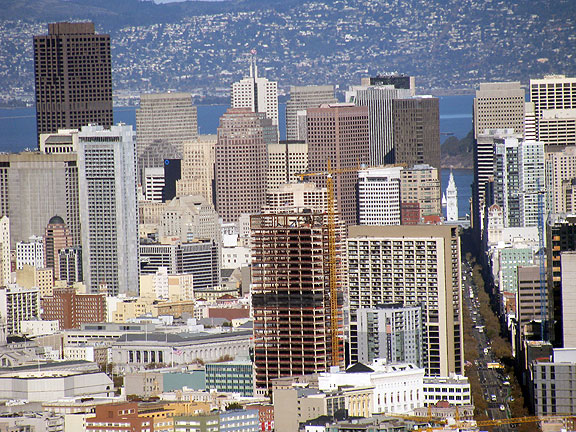
The frenzy of construction and upward growth continues unabated in San Francisco while we all await the next, inevitable crash.
As I read along I kept feeling like I’d seen all this before. And finally, about 75% into the book, Greenfield confirmed my suspicions. In his chapter on “overspecification” he points out the brittleness of their vision, the bizarre lack of flexibility, the sheer hubris of their overdetermined plans. For the Portuguese PlanIT Valley the designer
Appear[s] to allocate commercial, residential and retail sectors around a central public space, in a radial scheme as inelastic as Disneyland’s…The city’s functions are dispersed among discrete Retail, Residential, Research and Entertainment quarters, there to remain…the strict functional segregation of activity into designated, single-purpose districts is a hallmark of high-modernist urban planning, finding its earliest pure expression in Le Corbusier’s unbuilt Plan Voisin of 1924 and reaching an apotheosis in post-war plans like those for Brasília and Chandigarh.
Even before WWII the planners of Imperial Japan established a new capital city in their puppet territory Manchuko in northern China. Ian Buruma describes an eerily similar planning mentality that animated the fascists of the 1930s in his recent Year Zero:
The capital city of Manchuko, known in Japanese as Shinkyo or New Capital, was little more than a small railway junction called Changchun when the Japanese set up the puppet state in 1932. Almost at once teams of Japanese planners, engineers, architects, and bureaucrats of the South Manchurian Railway and the Kwantung Army set out to design the most modern, most efficient, cleanest, most orderly city in Asia, to be built in the “New Asian” style…On the flat northern Chinese landscape, covered in snow all winter, a brand-new city arose in five years of high-speed construction under the auspices of the State Council of Manchuko. If Albert Speer had been Japanese this would have been his monument to totalitarian planning: grandiose bureaucratic fortresses in the New Asian style flanking wide and perfectly straight boulevards leading to massive round plazas like the spokes of a giant wheel.
Utopians of the 18th and 19th centuries, from Robert Montgomery and Claude-Nicolas Ledoux to Charles Fourier and Robert Owen, all imagined ways to design utopian towns and villages. They sought to engineer human society in a way that would lead automatically to prosperity and happiness for all. Early urban planners pursuing these visions separated various activities into different sectors, much like the plans for the Portuguese PlanIT Valley. Even the 20th century modernist architecture of Le Corbusier was originally meant to satisfy needs for a new working class housing that would also facilitate social goals such as community, hygiene, efficiency, and more. So the claims of Smart City advocates turn out to be modern reformulations of very old fantasies.
Very little in the published PlanIT Valley or Masdar plans — or in Songdo, of what has actually been built — appears to respond to the collective insight we already possess regarding how urban space actually works, a line of thought so well developed that it has become conventional wisdom over the last half-century of urbanist discourse. And that line of thought suggests that cities work best when they support a lively mix of uses.
Perhaps tech firms have added a new wrinkle that they think gives them more credibility: the notion of transparent information. But drill down into the actual contracts and plans and you discover that the data collection that the whole Smart City scheme depends on is far from neutral.
Mystification of “the data” goes unremarked upon and unchallenged not merely in IBM’s material but in the overwhelming majority of discussions of the smart city. But different values for air pollution in a given location can be produced by varying the height at which a sensor is mounted by a few meters. Perceptions of risk in a neighborhood can be transformed by altering the taxonomy used to classify reported crimes ever so slightly. And anyone who’s ever worked in opinion polling knows how sensitive the results are to the precise wording of a survey. The fact is that the data is never “just” the data.
The information platforms projected to undergird Smart Cities are to be privately owned. No open source or free software here! “The smart city is a place where the technical platforms on which everyday life is built are privately owned and monetized, and information is reserved exclusively for the use of those willing and able to pay for it.” As Greenfield notes in one chapter, the whole model is based on a neoliberal sensibility in which government is stripped down to its most minimal functionality (primarily policing and systems administration), while as much as possible of the surrounding society is privately owned. Most of what people might do with and for each other is to the greatest extent possible monetized and commodified, to be packaged and sold to the residents (clients) of the new towns. Greenfield has looked carefully at the promises and projections of the various corporate plans and nowhere has he found anything to indicate open access to “disaggregated raw [data] feeds.”
It’s hard to believe that anyone in the world is actually advocating for technological efficiency in 2014 as the primary way to evaluate the social good, whether urban or otherwise. Most technical people show more humility when it comes to their own work, realizing as they must that things fail more often than anyone expects, and the human errors embedded in sophisticated technical systems frequently undermine their optimal functioning. But the assumption that human life should be subjected to a standard of technical efficiency is the root of the problem.
The persistence of the idea that a polity is something that can and ought to be managed like either a technical system or a commercial enterprise is hard to explain. Flawed at its very root, it betrays, at best, a shallow understanding of the mechanisms by way of which a city learns, diagnoses and repairs itself, utterly failing to account for the qualities which underlie love of place. A city whose interwoven processes actually were “regulated and controlled” as anticipated in this literature — where all the key performance indicators of superficial function were perpetually maintained within some nominal interval by computational oversight and not one thing allowed to interrupt the drive toward total efficiency — would not be a terribly healthy or a pleasant place to live.
The reality of city life, self-evident to anyone on casual reflection, is that it is a place that depends on countless interactions that go unmeasured and unremunerated. Our lives are based on profound and widespread cooperation and mutual aid, most of which we take for granted. None of these normal activities that go on all day between people in cities is accounted for in the gee-whiz techno-utopianism of the Smart City propagandists.
The presence in a city of technologies of ubiquitous data capture…is likely to suppress or displace activities…such [as]…provisions for housing and self-care, and community arbitration and dispute-resolution processes generally grouped under the anodyne label of “the informal sector.” They account for an astoundingly high percentage of total economic activity. They are critical to more recognized economic and social processes, even in what we are pleased to think of as the developed world. And they are entirely absent from the smart city’s account of itself…For me, the deepest truth of all about the smart city is bound up in that particularly infelicitous phrase from Living PlanIT’s material, “occupant support and convenience systems.” Every dive bar and every farmers’ market, every playground or cinematheque or Michelin-starred restaurant, all the bodegas, bike shops and edgy boutiques, the rib shacks and fetish clubs and flower festivals — all of that, and everything implied by them, Living PlanIT reduces to those five fatal words.

This mockup is from a student studio presentation last week at David Baker’s Storefront Lab on Shotwell Street in San Francisco. It depicts building designs prepared for the Seawall Lot 337 across Mission Creek from the Giants ballpark, and adjacent to Pier 50 (which in turn has subsumed the original Mission Rock,once far out in the bay). It is possible that the master developer here, the SF Giants, will opt for some version of these highrise plans for their new residential and retail “village” they are proposing to build.
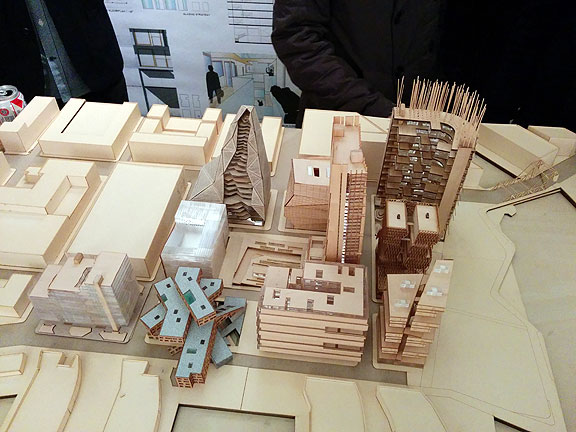
I actually like some of these designs, though would prefer to imagine them anywhere else but along the shoreline.
There is much more in Greenfield’s work worthy of quoting, but I think by now you, dear reader, have the basic gist of it. There is one more juicy bit though, and it’s perhaps the most important contribution of this polemic. Because it’s not just about so-called Smart Cities or even about urbanism per se, but rather about the deeper problem of Public Relations as Public Policy. That is, rarely do we see revealed clearly how manipulated our “permanent (bureaucratic) state” is by the puffery of advertising rhetoric promulgated by developer flacks and product managers of all sorts. Having gone through the absurd claims and embedded ideologies of Smart Cities propagandists in such detail, Greenfield comes to the wrap up and has to face the real question put forward by his work. Why did he spend “so much time and energy focusing on it?” It deserves a lengthy passage to understand the importance of this work, and the implications it has for critically analyzing much of the policy rhetoric emanating from planning bureaucracies and other public servants:
The smart city as we see it instantiated in places like Songdo may well have died aborning. Yet so much of what was intended for it has already passed unexamined into the assumptions enterprises like IBM and Cisco and Siemens make when they propose informatic systems for other, realer cities.
At the launch of any new corporate smart-city initiative, content promoting it and aligning it with the enterprise’s overarching brand proposition is generated by the marketing department, and released into the wild on the global website, where it will be indexed by Google in less than a minute. This initiative almost immediately comes to the attention of the planet’s several thousand technology bloggers, writing for outlets of various provenance, who generally have automated keyword searches set up to notify them whenever an item of interest is published. Because these bloggers are simultaneously under intense contractual pressure to post several times a day, are by definition enthusiastic about technology and are, by and large, unschooled in the arts of skeptical reportage, they tend to take the claims they are offered at face value. (This is true of bloggers writing for the Guardian or the New York Times every bit as much as it is of their less well-positioned peers.)
In a manner of minutes, talking points from the original press release are paraphrased in the blogger’s idiom of choice and bundled into a new post, and this may happen across dozens of competing sites in a very brief span of time. Links to these posts are, in turn, instantaneously produced by automated Twitter accounts, endlessly replicated both on Twitter itself and via other social-media channels linked to it through its API; these in turn spur a wave of response from a far larger number of people around the world who are equally excited at the prospect of living in the future, and within a few hours at most a rich loam of online commentary has been laid down. Very little of this commentary evaluates what is being claimed in any depth, or even compares the item at hand to previous assertions made by the same institution, but the volume of buzz is impressive. And due in no small part to the way Google itself works, this distributed colloquy creates an immediate impression that there is a there there. Over the space of a few hours, a framing or perspective originating in a deeply interested party has simply become an unquestioned part of the fabric of consensual knowledge.
What happens on the receiving end, inside the municipal bodies that constitute the primary presumptive audience for such a marketing campaign? Low-level bureaucrats, pressed for time and starved for insight, stumble onto this thicket of conversation via a cursory keyword search; they copy-and-paste a few lines from the first reasonably credible-looking search result into their PowerPoint slides, unmodified; and these slides then get submitted up the hierarchy. The language propagates across the institution — and, what’s more, it meshes with that found in the hurriedly-downloaded white papers on the subject that someone found on the website of a name-brand management consultancy. The savvier staffers start to feel confident using these terms: speaking in them, thinking in them. While misgivings may in fact be prevalent, there are likely to be relatively few in the bureaucracy who are able to express them forthrightly — that is to say, who are sufficiently comfortable with the technology to understand precisely what is being proposed, familiar with the way their city works to convincingly articulate why this is problematic, assured of their own position to feel safe in doing so and passionate about the issue to willingly shoulder the risk involved. (If, as the saying has it, nobody ever got fired for buying IBM, it’s also the case that one may find oneself on shaky ground contradicting something printed straight from the IBM website.) When finally pressed to make a recommendation as to how the city’s resources should be allocated, the easiest thing for a committee member to do is go with the flow, or to at least outwardly agree with the person at the table who seems to know what they’re talking about, simply to bring the drawn-out process of decisionmaking to a close.
This, in broad outline, is how a premature and preemptive consensus formed around the desirability of something called the smart city…To be precise, it’s almost exclusively a discourse about the instrumentation of the urban fabric and the quantification of municipal processes, specifically for ease and efficiency of management…In the end, this is why I believe it’s worth focusing a considerable amount of attention on the notionally temporary language of websites and interviews and expo stands. Quite simply, this rhetoric does work in the world. It sets agendas, influences perceptions of what it means to be “advanced,” recalibrates norms and guides the allocation of resources.
Clearly this process works behind the scenes all day every day, whether promoting the latest information technology for a local municipality or making a real estate development plan seem inevitable, or promoting biotechnologies like genetically modified organisms, etc. Penetrating the fog of this kind of everyday public relations and advertising work helps to rekindle the prospects of a proper democratic approach to such social decisions (at least these techno-scientific issues SHOULD be social decisions!). If we can re-situate ourselves vis-à-vis our built environment and the technologies we use everyday, we might begin to ask better questions. Greenfield leaves us with a few to ponder:
How might we use networked technologies to further the prerogatives so notably absent from the smart-city paradigm, particularly those having to do with solidarity, mutuality and collective action?
How might we inscribe a robust conception of the right to the city in all of the technological interventions proposed, including but not limited to those intended to enhance personal mobility, citizen engagement and processes of (individual and collective) self-determination?
And what alternative conceptions of technology in the urban everyday might support the open, tolerant, feisty, opinionated character we associate with big-city life, above all that quality variously described as canniness, nous or savoir faire?
Well? Let’s get on with these real debates, and leave the empty puffery of public relations in the dustbin where it should be properly resting.

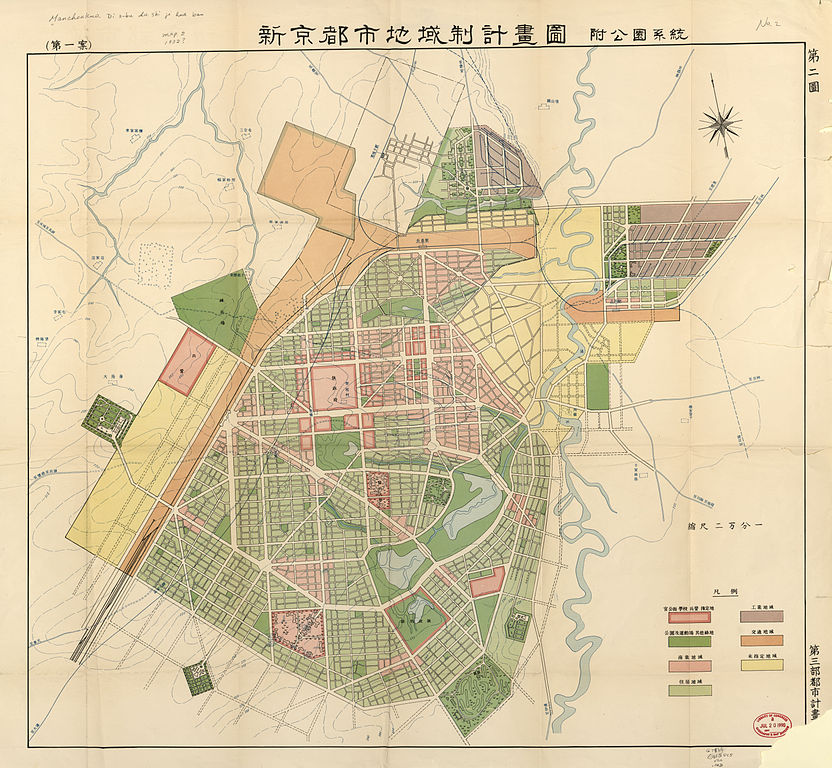
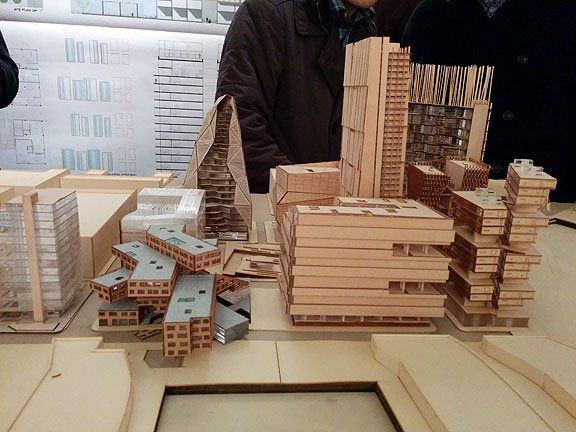











http://urbandatachallenge.org/urban-data-canvas/
Not free drinks, but friendly police to help you overcome your hangover:
The City of BoozeTown
In 1952 Mel Johnson presented investors with his idea of a perfect city—one built on booze. Every street would be a reference to alcohol, and they would even have their own currency called BoozeBucks.
There would be a local police system, the Party Police.
They wouldn’t arrest people — they would be more like roaming caretakers, giving drunks aspirin and kindly escorting them home when they got lost.
Most importantly, no children would be allowed in BoozeTown. Visitors with kids could leave them at the daycare/summer camp area outside the city. When completed, the city would have had moving sidewalks, breweries, distilleries, permanent housing, and even suburbs.
Johnson gave potential investors matchbooks and cocktail napkins, telling them:
“Just imagine . . . a resort entirely centered on the culture of alcohol. A boozer’s paradise built expressly to facilitate drinking and the good times that naturally follow. Where the bars, clubs and liquor stores never close. Where the police force is there to help drunks, not hassle them. Where even the street names salute sweet mother booze: Gin Lane, Bourbon Boulevard and Scotch Street. An adult playground like no other. Just imagine.”
Perhaps unsurprisingly, Johnson could never get funding for BoozeTown and have up on the idea in 1960. Still, it sounds like BoozeTown may have inadvertently inspired many virtual game worlds that have their own currencies, like WoW Gold, and (let’s face it) exist only to get people wasted.
See: http://www.drunkard.com/issues/55/55-boozetown.html
Yeah, but, free drinks! http://www.oii.ox.ac.uk/events/?id=644